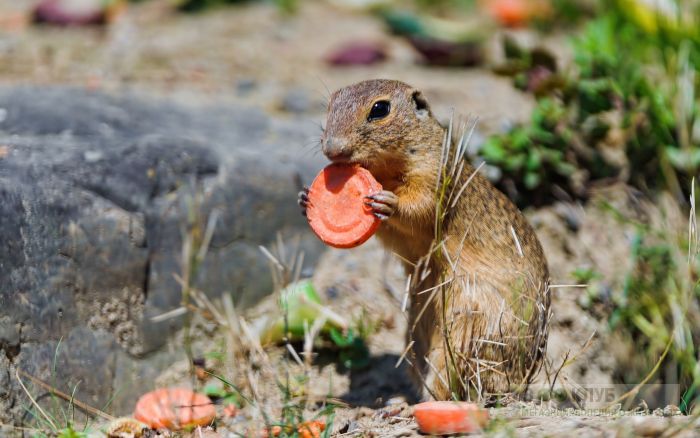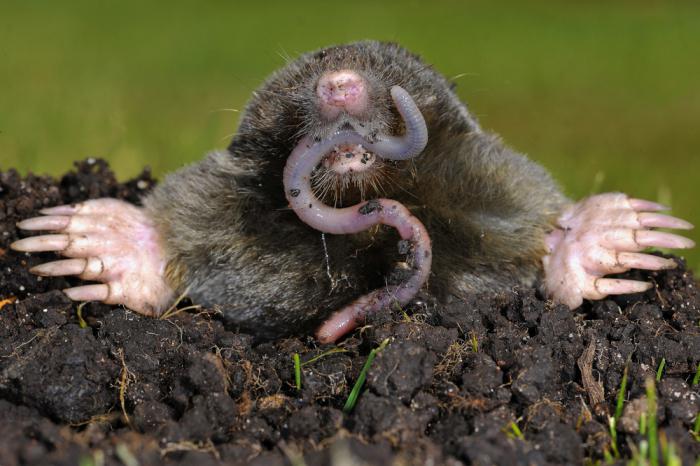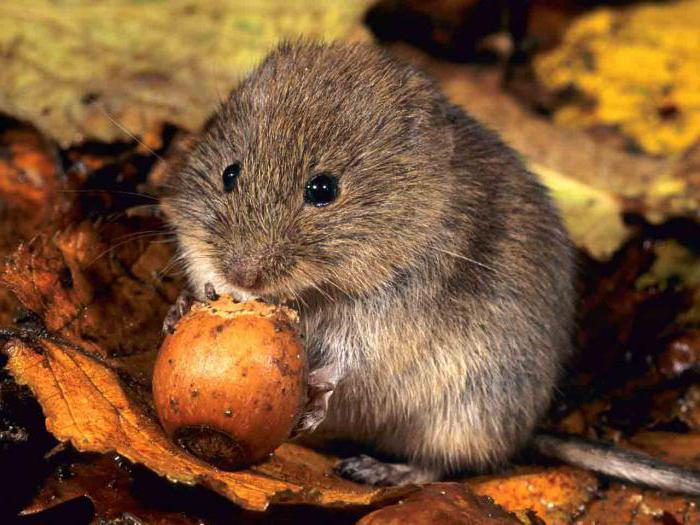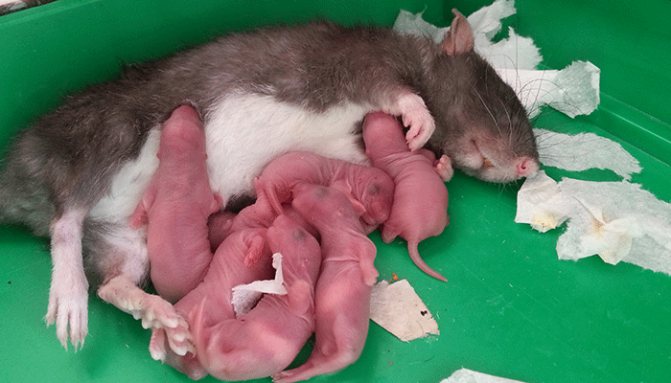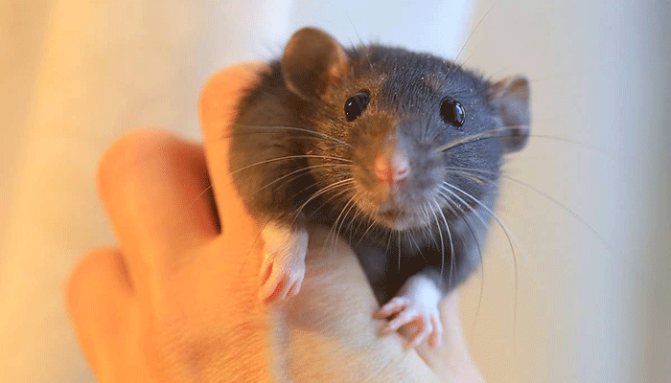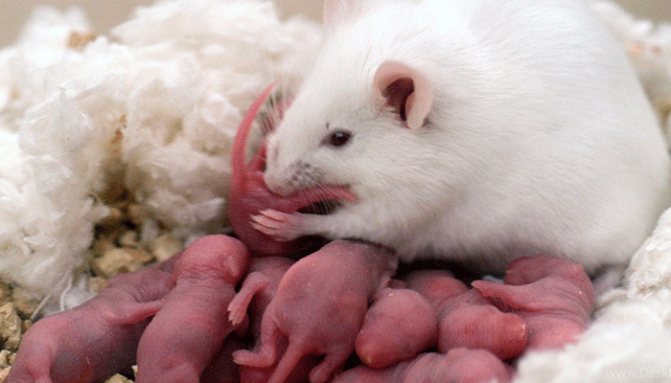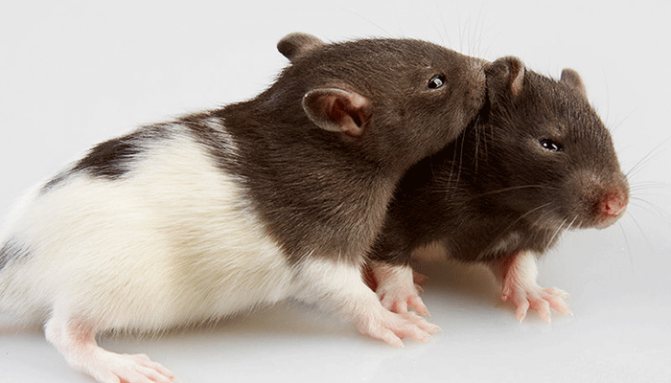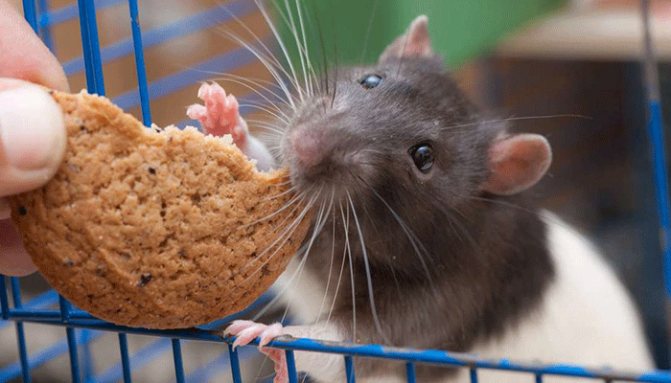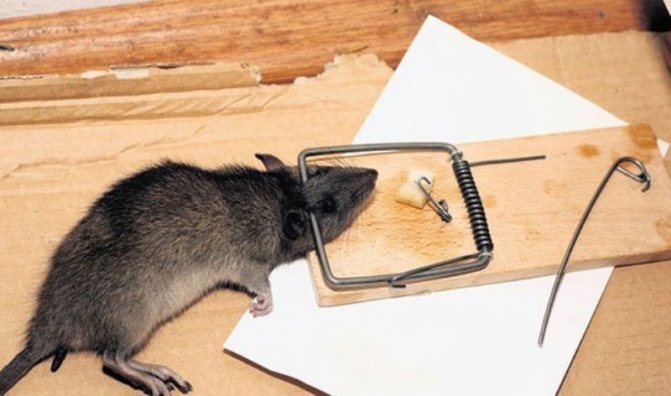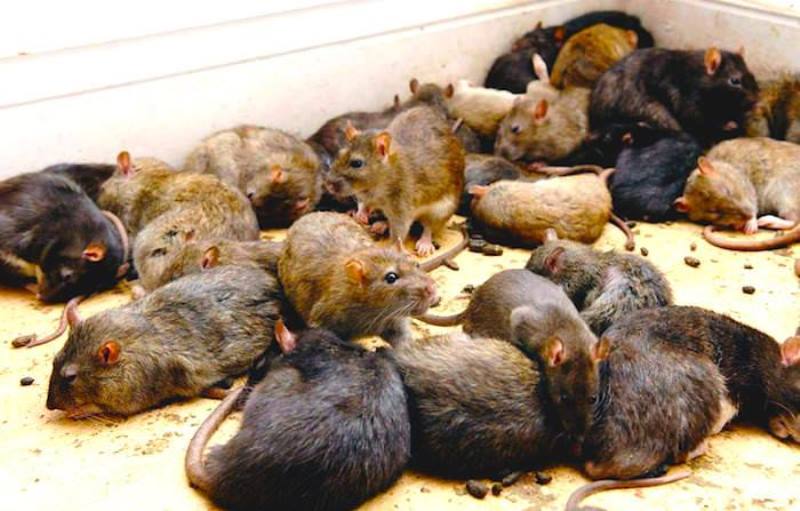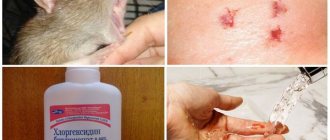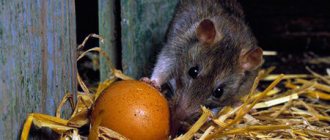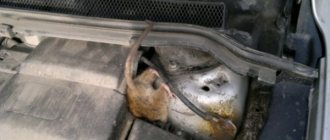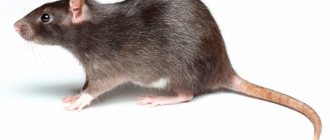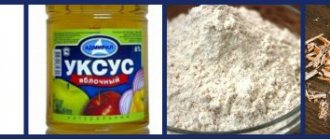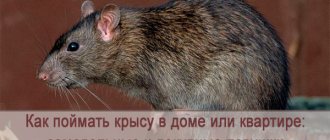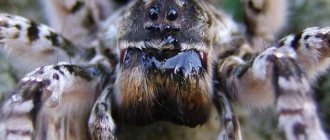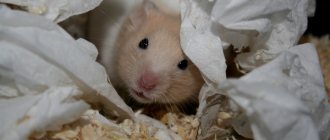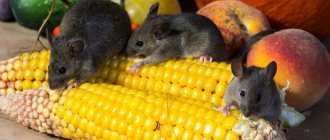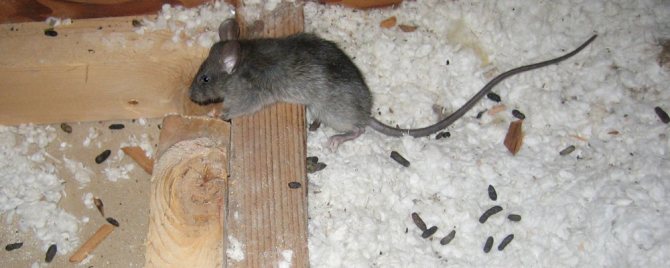
- 14 November, 2018
- miscellanea
- Yulia Kazakova
Not everyone can determine that the room is infected with rats or mice, given the secretive lifestyle these nimble rodents lead. After all, only at night do they go out in search of food. By looking at damaged food and torn bags and sacks, you can make sure that rodents are in the house. But which ones?
As a rule, mice leave small holes. But the rats tear thoroughly and roughly, so there are more holes in the bags. However, there is another simple and more striking sign indicating that gnawing pests are present in the house - this is mouse or rat droppings.
How rat feces differ from mouse feces
The faeces of rats differ from the faeces of other rodents not only in size and shape, but also in location. So the presence of brown animals is evidenced by spindle-shaped droppings, which lie in small heaps. It has a grayish tint and rather large particles. Very thin, about 10 mm long and almost black faeces leave black pests. The largest is the excrement of the Pasyuk (gray rat), they reach a length of up to 20 mm. Below you can see what the rat droppings look like in the photo.
You can use their excrement. Mouse feces are much smaller. They look like slightly pointed black granules, the length of which does not exceed 5-6 mm.
The photos below clearly show what rat droppings and single mouse excrement look like.
Difference in structure
There are two types of rats in houses - gray and black. The black one is covered with dark brown wool, so you can't confuse it with a mouse. The more common is the gray rat, or pasuk.
Pasyuk is a rather large rodent, the body length of an adult varies from 17 to 25 cm.In addition to size, there are a number of anatomical differences; you can distinguish a mouse from a rat by the following features:
- The length of the mouse tail is equal to the length of the body or slightly less, the tail is rather thin, covered with small hairs. The rat's tail is about half the length of its host, bald or bristly, powerful, especially at the base.
- Mouse ears are large in relation to body size, round, wide at the base, not covered with hair. Rat - small, triangular, hairy, tapering near the head.
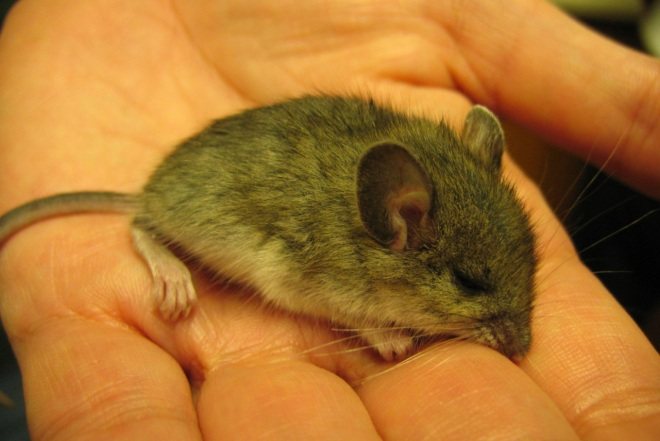

- The paws of the mouse are designed so that it is easy to climb vertical surfaces: thin, with sharp claws, fingers are located next to each other. Rat legs are wider and more muscular; these rodents run fast and jump well. There are membranes between the fingers; on the palm of the hand they look like large folds of skin.
- The head of the Pasyuk is longer, conical; in mice, the angle of the muzzle is much wider and is a flattened triangle.
- The eyes of the mouse are large, expressive, convex, they are clearly visible on the muzzle. Rat - smaller in relation to the body, deep set.
- The mouse's neck is almost invisible, the silhouette of the animal is close to the ball, while the pasyuk has a longer body and a well-defined neck.
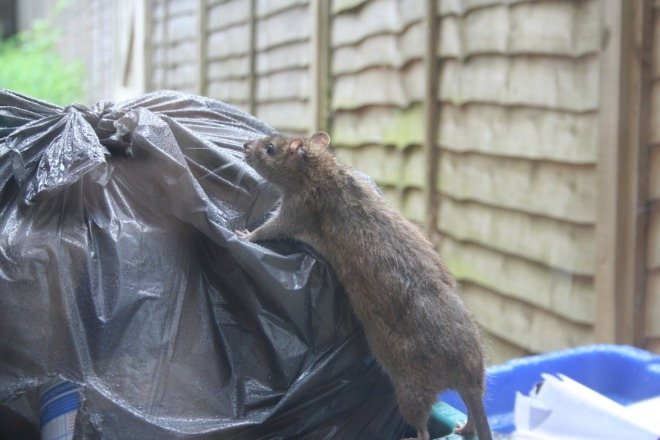

- The wool of the bulk of house mice is gray, with a cold shade, the color of the rat's wool is much warmer, brown or gray-brown.
We suggest that you familiarize yourself with which humidifier for children to choose
How rats appear in the apartment
But in fact, the list of what diseases can be infected from rodents is much longer.
The duration of the incubation period can be on the order of 7-46 days, but the most common period is days. The initial period, oligouric (characterized by hemorrhagic and renal manifestations), the polyuric period and the period of convalescence are those actual periods of the course of the disease that characterize mouse fever.
- Temperature rise up to 40 ° C;
- Muscle pain, joint pain;
- Chills;
- Nausea with alternate vomiting;
- Migraines of frequent occurrence;
- Deterioration of vision;
- Severe bleeding of the gums, as well as bleeding from the nose.
As for adults, mouse fever has similar symptoms, the general appearance of which is as follows:
- The temperature is about 40 ° C;
- Severe headaches;
- Increased sensitivity to light exposure, as well as pain in the eye area;
- Vagueness of surrounding objects, a feeling of the presence of a "grid" in front of the eyes;
- Rare pulse;
- Lowering blood pressure;
- Redness of the skin in the neck, face, eyes;
- The appearance on the 3-4th days of the disease of small spots of a rash, which are concentrated in the area of the sides of the trunk and armpits;
- Eye hemorrhage;
- Nosebleeds;
- Nausea and frequent vomiting.
Initial period. Its duration is 1-3 days, it is characterized by a rather acute onset. The temperature, as we have already indicated, reaches about 40 ° C, often accompanied by chills. There is a headache strong enough in its manifestation, the patient's condition is accompanied by dry mouth, general weakness.
2-4 - 8-11 days of illness. As in the previous period, the disease is characterized by an increased temperature, which lasts up to 4-7 days. A decrease in temperature does not lead to an improvement in the general condition, moreover, it may even worsen. Typical manifestations for this period are lower back pain with varying degrees of severity.
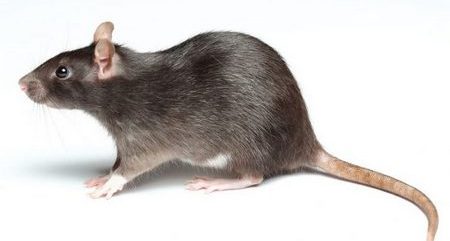

With the onset of pain in the lumbar region, vomiting also occurs (6-8 or more times a day), while it is not associated with the use of drugs or food. Also, there are abdominal pains, often bloating. A characteristic manifestation of the disease is expressed in kidney damage, which causes puffiness of the face, a positive symptom of Oliguria, pasty eyelids.
9-13 days. The period is polyuric. Vomiting stops, pains in the abdomen and lower back gradually disappear, appetite and sleep return to normal, the daily amount of urine excreted increases. Dry mouth and weakness persist, the recovery period begins gradually, with days.
Rats can spawn on any floor. They are not obstructed by concrete walls, wooden partitions or metal fences. Thanks to their sharp teeth, they turn a small hole in the wall or a small chip into a convenient passage in a short time. They move to the upper floors through ventilation shafts, the space between pipes or a garbage chute.
Most often, rodents start up in apartments where it is dirty, garbage is not removed for a long time. They are attracted by an unpleasant smell, they quickly find its source. Therefore, it is necessary to regularly take out the trash, wash the floors in the room. You can notice the presence of pests by certain signs:
- an unpleasant smell appears in the room, like from a hamster;
- feces appear - these are dark shiny balls of small size;
- in the evening, night and morning, in silence, you can hear a strong grinding and squeak;
- in houses you can see scraps of thread, papers or newspapers - these are kind of holes, they may indicate that the rat is preparing to become a mother;
- holes appear in the walls in rooms, bathrooms and other rooms;
- the packages in which the cereal is located are gnawed, the contents are poured out.
Rats can go without food and water for a long time. They jump beautifully, crawl in hard-to-reach places, and swim. Very tenacious, able to live in adverse conditions for a long time, even radiation does not kill them. Sometimes they flock and attack a person. Therefore, if rats are in the room, do not postpone their destruction.
How many rats carry rat pups
On average, the offspring of a domestic rat is from 8 to 15 pups
, sometimes the number of pups in a litter reaches 22 (!) individuals. Infrequent pregnancies are also quite rare, in which the female gives birth to only 2-3 rats.
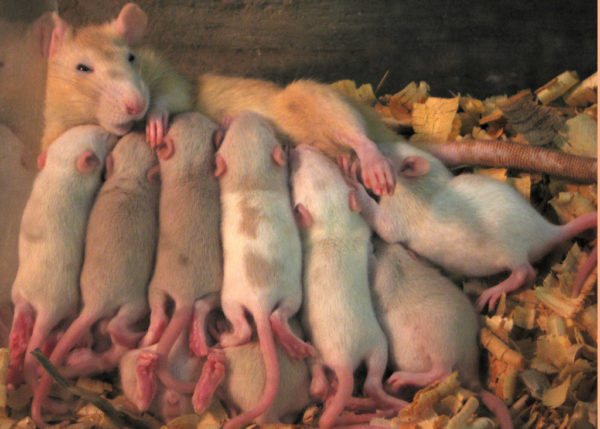

How many nipples does a rat have
The female rodent has 12 teats, so most often the litter consists of 12 cubs. With good nutrition, the animal calmly feeds up to 22 pups. The female divides the newborns into two groups and alternates feeding the cubs.
Rodents in human life
Not only does rat droppings evoke negative emotions in humans - they are very dangerous. Therefore, you should not allow this type of rodent to appear in the apartment.
Influence of rats on human life:
- They are carriers of such dangerous infections as plague, typhus, toxoplasmosis, rabies and other diseases, rat feces contain a large number of pathogens.
- Violate the emotional balance of a person.
- They cause economic damage, damage property.
- They eat up food supplies.
- Damage electrical networks, thereby causing a fire in the room.
Preventive measures
Compliance with cleanliness will avoid the appearance of harmful rodents in the apartment. Therefore, do not be lazy to clean the room.
In order not to start rats under the floor, it is necessary to perform elementary preventive measures:
- regularly get rid of garbage in the apartment;
- do not allow food leftovers on the floor;
- immediately throw away spoiled food;
- wash the dishes after every meal.
It is also always worth remembering that rats feel great near garbage cans and in the basements of residential buildings, since there is a large amount of spoiled food, and the unpleasant smell attracts them.
7 major diseases that can be transmitted from mice
A century ago, typhus and plague could be attributed to the most common diseases carried by rodents. But at the moment, only a few deaths from infection with such infections are recorded. Therefore, the attention of doctors is drawn to the following diseases.
Salmonellosis
Salmonellosis is considered one of the most common diseases transmitted by rodents. Infection occurs through contact with mouse feces. The danger of salmonellosis is that an infected person can also transmit the bacteria to anyone else. One of the strains of Salmonella (Enterica), provokes the development of typhoid fever. The disease must be promptly treated with antibiotics and vaccination because, otherwise, infectious-toxic shock may develop.
Leptospirosis
This infectious disease is caused by bacteria of the Leptospira species, which are found in the urine of infected rodents. Most often, leptospira enter the human body (through the mouth, damaged mucous membranes of the eyes and nose) after direct contact with mouse urine.
Residents and visitors of tropical and subtropical zones should be especially vigilant (the combination of high temperature and humidity is the most favorable for the multiplication of bacteria directly in contaminated water). That is why all guidebooks strongly recommend tourists not to consume fresh water from open sources.
The first symptoms of leptospirosis develop about 14 days after infection. They can be easily confused with common flu symptoms:
- headache;
- chills;
- muscle pain;
- nausea;
- vomiting;
- redness of the eyes;
- diarrhea;
- rash on the skin.
If you do not start treatment with special antibiotics, then a strong complication can develop: Weil's disease. Lack of proper therapy at this stage can lead to multiple organ failure, internal bleeding, and death.
The symptoms of Weil's disease are more "vivid" than at the initial stage of leptospirosis and it is quite difficult to miss them:
- jaundice;
- swollen ankles, hands, or feet;
- chest pain;
- convulsions;
- coughing up blood.
We suggest that you familiarize yourself with: Effective drugs for head lice
Tularemia
Tularemia is caused by the bacteria Francisella tularensis. From mice to humans, the disease can be transmitted by ticks and fleas. Arthropods feed on infected mouse blood, after which they can cling to a healthy person or wild animal. In rare cases, bacterial transmission occurs through the consumption of raw, unprocessed meat.
Fever may accompany the symptoms. An ulcer at the site of a tick bite is considered the most common sign of infection. Lymph nodes may also swell. The most severe form of infection will be accompanied by coughing, chest pain, and shortness of breath. If tularemia is caused by eating contaminated meat, mouth ulcers and tonsillitis will appear.
Bartonellosis
Bartonellosis is caused by a wide variety of Bartonella bacteria. The disease is transmitted from mice to pets through the bites of arthropods (ticks, fleas, lice). Moreover, from an infected animal to a person, the disease can get through an ordinary scratch (which is why it is necessary to regularly show pets to the veterinarian).
Patients with bartonellosis may develop symptoms of inflammation of the heart muscle (endocarditis, myocarditis). Antibiotic treatment will kill the Bartonella bacteria in a few days.
Hantaviruses enter human blood after direct contact with contaminated saliva, urine and feces, as well as inhalation of dust from mouse hair.
Most often, hantavirus infection affects residents of China, the Democratic People's Republic of Korea and eastern Russia. Europeans are usually struck by a hantavirus called Puumala. It is worth noting that in the western regions the disease is relatively mild.
There are eight main subtypes of arenaviruses that provoke similar diseases. Each of these seven types of virus infects only one rodent species in a particular geographic region.
| № | Name of the disease | Carrier mouse species | Distribution region |
| 1 | Lymphocytic choreomeningitis | Plain brownie | The whole world |
| 2 | Lassa fever | Natal multi-nipple | Central Africa |
| 3 | Lujo hemorrhagic fever | Not exactly defined | South Africa, Zambia |
| 4 | Argentine hemorrhagic fever | Calomys laucha | Argentina |
| 5 | Bolivian - // - | Calomus | Bolivia |
| 6 | Venezuelan - // - | Short-tailed reed | Venezuela |
| 7 | Crimea-Congo hemorrhagic fever | Field | Europe, Congo |
The causative agents of fever are transmitted to humans through the consumption of contaminated food or agricultural work. Some of the arenaviruses can be transmitted from a sick patient to a doctor if the latter has had direct contact with contaminated blood.
Toxoplasmosis
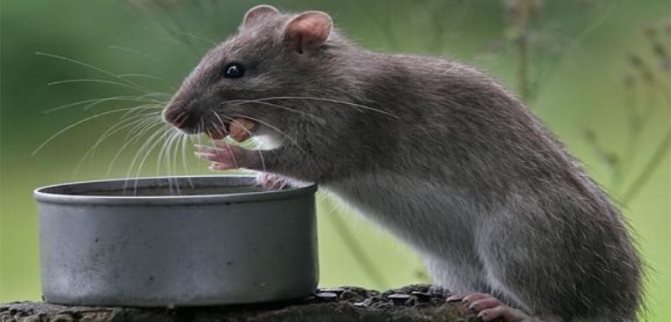

Toxoplasmosis is provoked by the simplest toxoplasma. Although the domestic cat is the primary vector, mice are considered to be intermediate carriers of the virus. Most people may not have symptoms throughout their lives. In 90% of cases, toxoplasma is found in pregnant women during routine blood tests. The disease can lead to miscarriage, stillbirth and other health problems in the fetus.
Of course, these are not all diseases transmitted from mice to humans. But it is the above diseases that are most often diagnosed after contact with rodents.
From childhood I was afraid of all sorts of rodents.As I see, the hair on the back of the head is already standing up! Of course, an unpleasant sight. And what to say about their harm - everyone already knows this. Once, with a peripheral vision, I saw something small dark slid along the wall and hid behind the cabinet. Oh God! It was a mouse. I immediately began to learn among my acquaintances, on the Internet, how to deal with them. It turned out that there are many effective methods and means. How to destroy rodents - I share all the methods I know!
Bartonellosis
How are diseases transmitted?
A person can contract any infection from rats and mice indirectly - through contact with a domestic cat.
Any disease, such as the plague or rickettsia bacteria, can be transmitted to humans in various ways:
Let's consider the main diseases carried by rats and mice.
Bubonic plague
Salmonella
This disease, spread by rodents, is not uncommon. Most often, infection occurs as a result of the consumption of contaminated food, and developed gastroenteritis becomes the cause of death. often affects pets.
Sodocosis, or rat bite fever
It develops as a result of bacteria or fungi entering the body and is accompanied by inflammation of the skin, vomiting, and muscle pain.
Leptospirosis
The carriers of this deadly disease are directly rats and mice, and the causative agent of the bacteria Leptospira, which infects not only humans, but also many domestic animals. Most often, the infection manifests itself in temperate and tropical areas. Some people with leptospirosis may not have any symptoms, while others are very ill. In addition to rodents, some species of wild and domestic animals, for example, cattle, pigs, dogs, and raccoons, can carry bacteria and spread infections through urine. The most common causes of human infection are soil and water contamination.
Tapeworms of the genus Hymenolepis
They often live in rats and can be transmitted to humans through the consumption of food and water contaminated with rat droppings, for example, if you do not wash your hands before eating. Eggs of worms, getting into the human digestive tract, develop into mature individuals and begin to multiply.
Murine typhus
Transmitted from mice and rats by bite. The disease is treatable with antibiotics, but can be fatal in elderly and debilitated people. Illness symptoms: vomiting, fever, headache, cough, and muscle pain.
Causative agent of lymphocytic venezuelan encephalomyelitis
Migrates in populations of the common house mouse. Household rodents can become infected after contact with wild animals at the pet store or at home. Pregnant women are at greatest risk because infection can lead to birth defects and mental retardation in the unborn child.
Hantavirus infection
It can develop in the human body and includes four subspecies:
- Hantaan;
- Seoul;
- Dobrova;
- Puumala.
These species are pathogenic to humans and infection occurs by inhalation of the virus or from the feces of infected rodents.
The increase in rodent populations depends on changes in the climate of a particular region. In this regard, hantavirus infection is sensitive to climatic conditions, and high temperature conditions in summer and autumn can be prerequisites for possible outbreaks of the disease.
Tularemia
Another disease, which is carried not only by domestic game rabbits and some other animals, but also by rats and mice. Infection occurs through contaminated food or water.
Control methods
Rats in the apartment, what to do? There are several ways to exterminate rodents. They are all effective under certain conditions. Destruction is carried out:
- traps;
- chemical method;
- folk remedies;
- ultrasonic devices;
- with the help of professional specialists.
To destroy rats forever, you need to assess the situation, decide on a method, and then start fighting.
Traps are considered effective if there are several individuals in the apartment. The devices are easy to use and have different designs. Be sure to install baits in them. Traps should be placed in areas where rats are most often seen or excreted. The animal goes to smell the food used in the device.
Chemical method
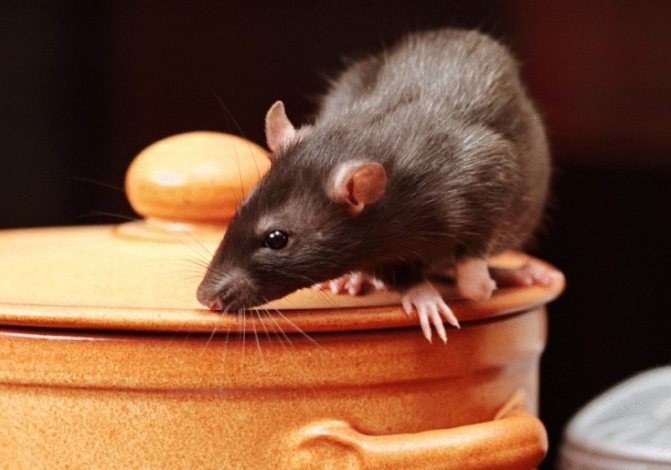

You can get rid of rodents using chemicals. They are sold in specialized stores. The most popular are:
- Ratid-1. The product in granules is used for any type of premises. Destroys pests in a short time. It is enough to scatter the drug in places where animals appear, but you should be careful to see that the agent does not get into human food.
- Goliath. A very effective remedy, often used by professionals. The drug destroys rats in 14 days. This is a very important point, as they are considered cautious rodents. Seeing that everything is fine with the rats who have tasted the poisoned food, the rest will also begin to eat it. The drug affects the blood and mind of the animal. For 10 days, the blood coagulates, consciousness is lost, oxygen starvation sets in. As a result, in 2 weeks, you can completely get rid of the harmful inhabitants of the apartment.
- Ratin. A popular remedy that kills rodents instantly. The ampoule of the drug must be added to 500 g of seeds, mixed with 3 drops of vegetable oil. Lay out the bait in the places of movement of animals, it is allowed to use the product with fish, meat, cottage cheese. After eating poisoned food, a rat dies within 2 minutes.
The chemicals are very effective against rodents. They kill the animal in a fairly short time. In this case, it is necessary to be as careful as possible when working with drugs, to ensure that they do not get on the skin and food of a person.
Folk remedies
Folk remedies against rodents are considered effective and safe for humans. However, it is worth assessing the number of rodents in the apartment, suggesting whether it is rational to deal with them on your own, or whether it is worth calling professionals.
Rodents can be destroyed with the help of such folk remedies:
- Get a cat. It is considered the most common way. However, you should get an adult cat that has developed hunting instincts. Some cats are lazy or afraid of rats. Rats smell the hunter, which will scare them away forever from the room. The hunting cat will not allow the rats to appear in the apartment again.
- Make bait. To do this, take gypsum and flour, mix in equal proportions, divide into several parts, and spread it around the house. The rodent will eat food, after which it will definitely want to drink. The gypsum in the stomach will harden after a short period of time, the animal will die.
- Ash use. Rodents do not tolerate its smell, so ash must be decomposed in places of their appearance. The substance gets on the skin of the animal's paws, begins to irritate it, thereby driving it out of the apartment. Using this method will not allow pests to appear in the apartment due to the negative effects of the substance on their body.
- Rats dislike plants such as peppermint and black root. You can put flower pots with these plants indoors, the smell will scare away pests forever.
- If a person has noticed that harmful rodents have started to grow in his apartment, then all the holes in the walls should be repaired as soon as possible. However, it should be borne in mind that concrete, wood, cardboard and ordinary foam are not an obstacle for animals. Therefore, it is necessary to use sheets of iron, a mixture of concrete and crushed glass.
- The destruction of rats can be carried out using crushed glass. To do this, it is placed in a crumb of bread or other products, baits are laid out throughout the house. The glass will have a negative effect on the internal organs of the animal, after a short time it will die.
- Using special glue. This product can be purchased at any hardware store. It is applied to cardboard, which is placed where rodents most often appear. The animal is firmly glued to the cardboard, cannot budge. After the rodent is caught, it is necessary to throw it out, after feeding it with poison.
We suggest that you familiarize yourself with: How to remove flies in the house
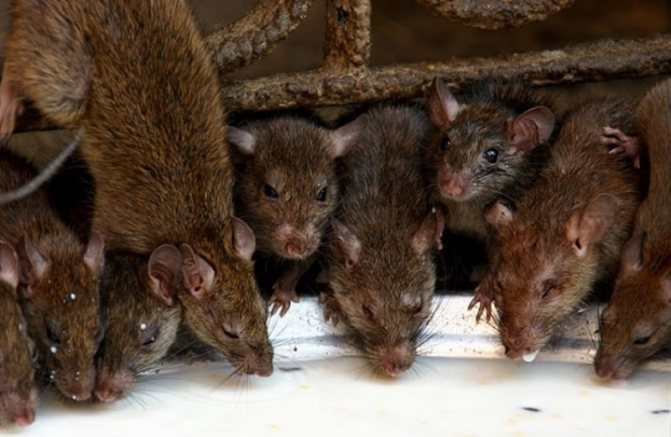

These pests can be driven out forever, for this it is necessary to use special methods of control
Folk remedies
Bad habits of tailed guests
Mice living in houses and apartments are detrimental to the family budget, because gnaw and spoil:
- Products;
- Stuffed Toys;
- Clothes and shoes;
- Furniture and other household items.
And sometimes they chew on electrical or telephone wires, and as a result, the whole house may be left without electricity and without a telephone connection.


Mice spread various dangerous diseases: typhoid, salmonella, dysentery and even plague. The excrement of mice contains many microbes and infections, which leads to the occurrence of helminthic diseases. Therefore, it is recommended that you quickly get rid of rodents using proven methods. If a hole is found in the corners and baseboards of the apartment, you must immediately sound the alarm and place mousetraps next to this hole.
Small rodents are very resistant to cold, easily endure any bad weather conditions. Their body can assimilate poison and withstand fasting for days.
Why are mice and rats in my house - I understand the reasons
Before moving on to action, it is worth figuring out why mice or rats are in the house.
To begin with, these are, first of all, living beings, and they are driven by the instinct to seek food. That is, for them, the object of increased attention will be the dwelling where there is free access to food. Even if they settled with neighbors, sooner or later they will go to inspect other possessions. And if they find something edible, they will gain a foothold in this territory.
Where do these mammals come from? They start in places where they live well: where no one bothers them. Landfills, trash cans, warehouses are habitats. Basically, there are poor sanitary conditions, and rodents cannot be destroyed.
They can get to our homes in many ways: migration from other homes, transportation of things, delivery of household appliances from warehouses.
For mice and rats, the most favorite places are individual houses, where there are cellars, underground, outbuildings with domestic animals and grain supplies. The last place is generally paradise for them, there is always something edible there.
Mice are very brave rodents, they settle next to humans in apartments. And they are not limited to the first floors, rising much higher. Although the first one is more convenient, since it is easier and faster to get to it from the basement. Dwellings in which there is open access to food or, due to poor cleaning, dirt and pieces of food remain, become places of active development for mice.
From all that has been written, I draw one conclusion: often a person and his actions become the cause of the appearance of rodents. And all because many of us are lazy. Scattered bread crumbs, a pile of dirty clothes are the most favorable environment for uninvited guests.
Simple and easy guidelines for dealing with mice


Leaves of mint, wormwood, tansy, black root, dried chamomile flowers, rosemary sprigs should be laid out on shelves, in cabinets, next to rodent minks.
This method is suitable for humane disposal of rodents. You can use not the plants themselves, but alcoholic tinctures or essential oils.A few drops of such liquid next to the supplies in the cellar - and the rodents will not touch them.
What to do if a rat gets started
If a person has a suspicion that a rat has appeared in the apartment, then you should first of all pay attention to whether there is its excrement on the floor in the rooms, as well as an unpleasant smell. If the fears are confirmed, then do not panic, the following measures should be taken:
- First of all, consult with the SES staff and notify the management company about the problem.
- What to do with the rats in the basement must be decided by the employees of the management company. When deciding to use toxic substances, it is necessary to notify all residents of the house about this, who will take measures against the penetration of rodents into the apartments.
- In large cities, special means are used to kill rats that mummify the animal. After death, such an animal does not emit an unpleasant odor, thereby not scaring off other individuals. Therefore, the drug is very effective against rats.
If rats appear in the house, then you should immediately begin to destroy them. In this case, you should not panic, you need to act quickly.
Rules for the destruction of rodents using mousetraps and rat traps
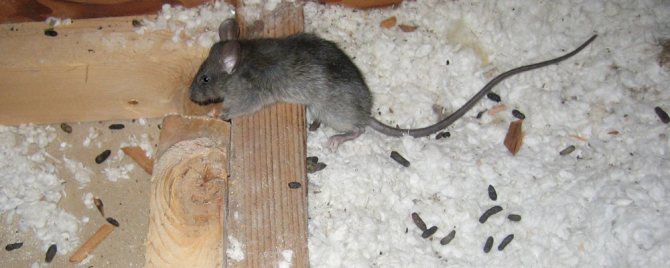

When, by the litter, you managed to recognize who settled in your house, you can go for traps and traps. Spring traps against rats are a very good remedy. Think back to where you've most often seen mouse droppings. This will help to trace the path of the rodent from the mink to the feeding site. Most often, an unclosed or not tightly closed garbage can acts as its role. But mice will not mind gnawing through the back wall of the kitchen set.
Do not try to fill the gap that rodents enter the house through. This will only make them behave more cautiously. In addition, they will gnaw through their own moves in another place, and this is again damage to the baseboards and other finishes, which means an extra waste of money. Therefore, try to fish them out through one initial slot.
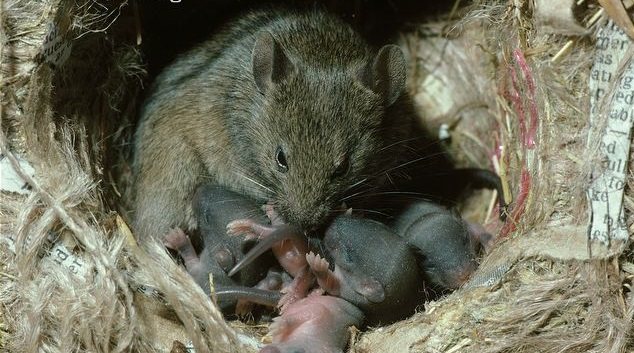

It is best not to place the mousetrap directly next to the gap. The mouse will smell the bait from a distance. And if one of the mouse relatives constantly dies near the crack, this will alert the rest of the fraternity. During the night near the gap, you can catch only one mouse, since it will simply scare the rest with its dying screech. If you place mousetraps around the entire perimeter of the room in which they eat (as a rule, this is the kitchen), you can catch up to 3 - 4 pieces per night. It is the same with rats.
How did I know they were rodents after all?
Before I saw a mouse moving around the perimeter of the room, I used to suspect that someone other than me was living in the house.
This was indicated by a number of signs:
- Gnawed food and things. It is easy to see, the main thing is to conduct a thorough inspection in the house. Gloves must be worn before handling suspicious objects with traces. Two fingerprints remain from the teeth of mice and look like two parallel holes with superficial grooves.
- Excrement. Mice look like grains, rats look like heaps of different sizes. If such an unpleasant thing is found, you must immediately begin to destroy them!
- Spots. Rodents, as a rule, move along the same paths, the so-called paths along the same route. Rubbing the wool and the floor surface will leave stains. By following these spots, you can easily find a "den" of pests.
- Tracks. Clearly visible on dusty surfaces. According to them, you can determine who settled at home and the number of such guests.
- Rodent corpses. They simply cannot appear in the house. This means that a whole detachment of animals has settled somewhere.
- A specific odor similar to ammonia. A rather dubious sign, but if there are other pointers to rodents, then it is worth sounding the alarm - mustache-tailed pests have really settled in the house.
How to identify a mouse
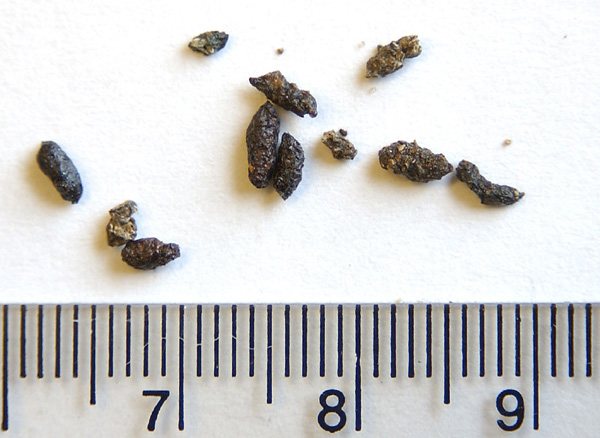

The properties of mouse droppings are as follows.Each individual mouse "poop" rarely reaches more than 6 mm in size. Basically, within 4-5 mm. Mice rarely grow to large sizes. But then they take in numbers. Often, small feces can be found next to large ones, up to 3 mm long. This means that a brood has already occurred within the boundaries of your house and there are both adults and young animals in the family.
What does mouse droppings look like from geometric data? Most often these are oval granules, somewhat vaguely similar to oats, only with rounded edges. Their color can change depending on what the mice eat. If it is cereal or bread, then their droppings are light gray. It happens a little darker, it happens a little lighter, but it is never black. This is already the color of rat droppings.
Why are mice and rats dangerous for humans?
The beginning of the summer cottage season is not only outdoor recreation and work in the garden, but also a massive awakening of rodents. The most dangerous thing for summer residents is cleaning the garden house and the area where rodents have already been running around, leaving their excrement. It is through the waste products of rodents that you can contract a deadly disease - murine or hemorrhagic fever. It is enough to inhale even the dust when sweeping a country house or cleaning an area to get sick with a dangerous disease.
Also, the infection can enter the body through the use of contaminated food, through dirty hands, water and damaged skin. Sometimes infection occurs through direct contact with rodents or with their feces.
The disease is characterized by a sudden onset, in which the temperature rises sharply to 40 ° C and a headache and weakness appear. Then these symptoms are joined by pain in the abdomen and lower back, dry mouth, and a decrease in the amount of urine, which indicates damage to the kidneys. The disease proceeds with acute complications, a rash and hemorrhages in vital organs may appear on the skin. Self-medication of hemorrhagic fever is unacceptable!
When the first symptoms of the disease appear, immediately call a doctor at home. The earlier the patient seeks a doctor, the greater the chance of a successful cure. For the entire period of treatment, patients must comply with bed rest, treatment, depending on the severity of the disease, can last from 7 days to 1 month. The patient does not pose a danger to the people around him.
Kidney function after illness is restored only after two years. After discharge from the hospital, it is necessary to strictly follow the diet, exclude alcohol, canned foods containing vinegar. You should also avoid strenuous activity for one year. If a person has had a mouse fever once, then immunity is maintained throughout his life, that is, he no longer becomes infected with this dangerous disease.
The danger of the disease lies in the fact that its incubation period lasts from 3 to 4 weeks. During this time, people forget that they cleaned in the country or went to the forest. And they take the first days of a rise in temperature for a cold and do not go to the doctor. After a few days, the patient's fever subsides and nausea and vomiting begin, pains in the lower back and abdomen appear, then only many patients call an ambulance.
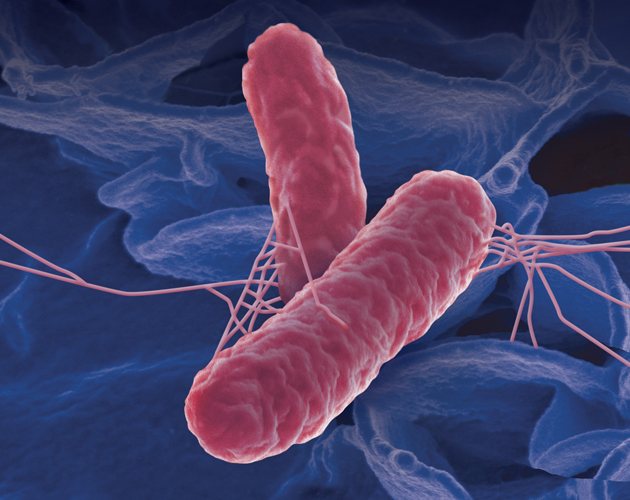

1. House cleaning should be done only with a wet method and the room should be well ventilated so that dust does not fly. Add chlorine disinfectants to the water.
2. When cleaning the site and at home, you must wear a mask or respirator on your face. Be sure to wear gloves on your hands. The gauze bandage should be 4-ply.
3. Drink only boiled or bottled water. Wash dishes, vegetables and fruits thoroughly and pour over with boiling water before use.
4. While at the dacha, wash your hands thoroughly with soap and water before eating and observe the rules of personal hygiene.
five.Do not eat foods that may have been contaminated by rodents without heat treatment. Do not place bags or food bags on the floor or on the ground. They should be suspended from a tree, stored in a closed car, or in containers inaccessible to mice.
6. Try to stay in the sun more, the virus of mouse fever dies from exposure to ultraviolet rays. Bring bedding from the garden house to dry in the sun or iron.
We suggest that you familiarize yourself with: What do fleas look like in humans
7. If you smoke, do not touch the filter with dirty hands.
8. Treat all abrasions and scratches with iodine or brilliant green, 3% hydrogen peroxide, 70% alcohol.
9. Place in the house and under it the means for killing mice. Buy them at specialized pharmacies.
10. Never touch dead rodents with your hands.
Remember, mouse fever is easier to prevent than to cure. Do not be afraid to send your child to the camp, not one of them will be allowed to open without sanitization. To protect your children and loved ones from mouse fever, try to carry out the same treatment in your country house.
Materials for placement and wishes, please send to the address
By submitting material for posting, you agree that all rights to it belong to you
I had never even thought about the danger of rodents to humans before. It turns out that they are carriers of many diseases.
An acquaintance who works at Rospotrebnadzor told me more about this.
Here's what I learned from our conversation:
- Rodents are sources and carriers of many infections. For example, they carry the plague, pseudotuberculosis. They also take part in the spread of leptospirosis, salmonellosis, typhus, encephalitis, fever, anthrax, trichinosis.
- They spoil stocks of food, vegetables, grain.
- By their actions, they damage buildings, warehouses, houses, and pollute them with excrement.
Mice, rats, and other rodents are regulars in unclean places, they live in landfills, warehouses, in abandoned premises. They do not sit in one place, they constantly move to different buildings, houses, where they pollute them with their waste products. Thus, rodents are a kind of repository of harmful microbes.
Human infection occurs very easily in several ways:
- Eating foods with pest feces.
- By touching infected things.
- By drinking untreated water, for example from wells.
- After being bitten by insects that have had contact with sick rodents.
An employee of Rospotrebnadzor gave me a small memo:
- If rodents appear in the room, immediately take measures to destroy them.
- Do not eat foods that have traces of the activity of mice, rats, do not pick vegetables, berries, fruits, mushrooms damaged by them.
- Observe the cleanliness in the house, the adjacent territory, remove garbage in a timely manner.
Which doctor to contact
If, after contact with the waste products of pests or their bites, you have a suspicion that an infection has entered the body, immediately consult an infectious disease doctor.
Signs such as headache, general weakness, aching bones and muscles, chills should be alerted. Often, in addition to the infectious disease specialist, the victim is referred to a surgeon. He will also inspect the wound and treat it with special means.
The first self-help with a bite before contacting a specialist is to rinse it with running water for 10-15 minutes with laundry soap. For primary processing, any alcohol-containing preparation is suitable - cologne, vodka, medical alcohol.
How to destroy mice and rats in your home - proven remedies and results
Very simple! The main thing is to be in all weapons. Everything will come in handy - the experience of friends, information from the Internet, tips from sellers from shops of garden and dacha inventory.
After all, everyone remembers what problems rodents can bring with them:
- The grandfather's method, the most proven and ancient, is a well-known mousetrap. A unique invention of mankind, so simple but so effective. People have been killing rodents with it for several hundred years. There is a mouse in the house - do not hesitate to buy a mousetrap. From my own experience, I will say - a productive thing. How many times I have used it - I always found a trophy in it in the morning. The bait for the mousetrap is a piece of food, I put sausage, meat - the mouse will definitely not refuse such products!
- A trap soaked in glue. A mouse, in contact with such a trap, simply sticks to it and can no longer move. You can also install a similar device yourself using cardboard and special glue (sold at hardware stores). The glue is applied to cardboard and installed in areas frequented by rodents.
- Ultrasound. A modern remedy, in addition, it will help in the fight against many insects. The principle of operation of the device is simple. It transmits electromagnetic pulses. They, in turn, act on rodents in a certain way - they cause anxiety. You need to install it in those places where the activity of mice is high. An excellent, effective remedy, even if it is not cheap, it is guaranteed to rid the house of pests.
- Poison. I note right away that it is not suitable for everyone. I have a small dog at home, and I did not resort to this remedy. Modern poisonous substances work in two directions: they kill the animal and contribute to its rapid mummification, that is, the body will not exude putrid "odors", but will dry out quickly.
- Special services. They specialize in removing a variety of pests. Professionals will do their job quickly, efficiently, and safely.
The most important point is to do it without delay.
These methods and means are the most effective and affordable, they will 100% rid the house of mice and rats.
What do the footprints look like?
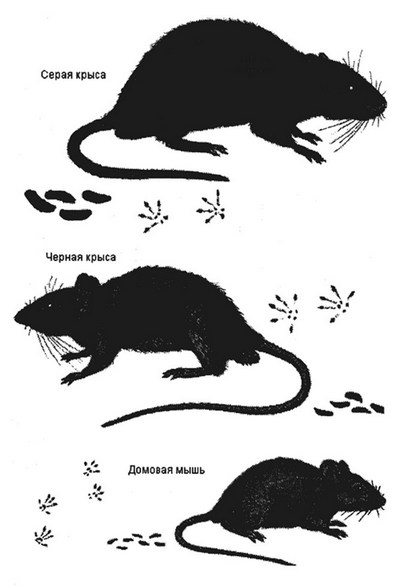

What do rodent tracks look like?
The print of the front paws of rat paws on wet ground or snow is approximately 1.5x2 cm in size. You can see the traces of 4 fingers, which are widely spaced. The hind legs are larger (up to 4 cm), however, during the movement a small imprint remains - 2x2 cm, that is, the trace is only partially displayed. If the animal moves slowly, a thin chain of prints will remain on the surface. During the jump, the rat leaves rare traces - at a distance of up to 1.5 m.
The paw prints of mice during a jump are characterized by a smaller step (up to 30 cm). The tracks form a semblance of a trapezoid: the hind legs, when moving, the mouse is wider, pushing off with the front, closely spaced legs. As a result, the traces of the hind legs remain in front, and the traces of the front ones - behind. In addition, a thin line is visible behind - from the tail.
Litter
When solving the problem of how to distinguish a house mouse from a rat, you need to pay attention to their waste products, since often this is the only thing that reminds of rodents. The difference between rat and mouse droppings lies in shape, size, and location. Rodents of different species leave waste products that are different in color and size. So, the droppings of a black rat are large formations up to 12 mm in length, dark in color.
After the red brethren, the droppings remain, resembling the shape of an oat grain, the color is brown. Mouse feces are small, outwardly similar to pointed granules no more than 6 mm in size. In addition, mice empty themselves randomly, and rats usually leave droppings in one place.
Interesting video: Smart Rats
Determination of the type of rodent by the type of spoiled food
Preferred foods are hit first. For mice, these are cereals. Moreover, they leave behind a large amount of litter, husks, but the rat eats the whole cereal. In addition, large rodents do not feed in one place for several days, so the damage they cause is always greater.If the mouse each time returns to the same place for food (for example, a bag or bag with cereals), then the rat's teeth marks remain everywhere: on furniture, food: cereals, fruits, etc.
For a person who has never encountered a vermin attack, all rodents seem to be the same. A grayish color, a nasty squeak, short legs and a long tail are sufficient characteristics to determine whether an animal belongs to a particular order. But as soon as it comes to deratization, it turns out that the same bait acts on rodents in completely different ways. It is then that the question arises: "What is the difference between a mouse and a rat?" Below are the salient features to help you identify your rodent type.
There are only three types of pest rodents that are not afraid to settle near people. Due to the ability to adapt to the human environment, and at the same time not to be domesticated, this type of animal is called synanthropic.
In residential buildings and in grocery warehouses, you can meet:
- brown rat;
- gray rat (Pasyuk);
- house mouse.
All other types are either afraid of humans and settle in the wild, or are considered "pure", domesticated (white rat, decorative mouse).

